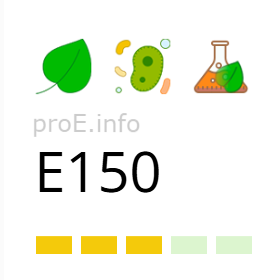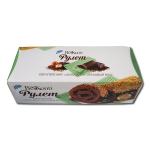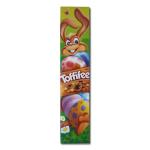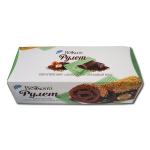
Other names for the additive (synonyms)
General Information
The additive E150 (Caramel color), more commonly known as caramel or burnt sugar, is a water-soluble food colorant. Additive E150 is a more oxidized form of caramel than the one used in candies and confectionery products. E150 has a burnt sugar aroma and a slightly bitter taste. Its color can range from light yellow and amber to dark brown.
Although the main function of caramel coloring is to provide color, additive E150 also has several additional functions. In soft drinks, E150 acts as an emulsifier to prevent cloudiness and the formation of flakes. This is due to its light-protective properties, which prevent the oxidation of flavor components.
The Joint FAO/WHO Expert Committee on Food Additives (JECFA) classifies caramel color into four classes based on the production method and physical properties:
- Caramel color I (additive E150a) – plain caramel, obtained by heat treatment of carbohydrates without using other reagents;
- Caramel color II (additive E150b) – caramel obtained using the alkali-sulfite process;
- Caramel color III (additive E150c) – caramel color produced via the ammonia process;
- Caramel color IV (additive E150d) – caramel produced using the ammonia-sulfite process.
Additive E150 is produced by heating carbohydrates, usually in the presence of acids, alkalis, or salts. This process is known as caramelization. The caramel color is made from inexpensive and widely available nutritional sweeteners. The main raw materials include fructose, dextrose (glucose), invert sugar, sucrose, malt syrup, molasses, and starch. Acids used in caramel production may include sulfuric, sulfurous, phosphoric, acetic, and citric acids. In the alkaline method, ammonium, sodium, potassium, and calcium alkalis are used. Additionally, hydroxides and salts of ammonium, sodium, and potassium (carbonates, bicarbonates, phosphates, sulfates, bisulfites) may be used in the process.
Molecules of caramel color may carry a positive or negative residual charge depending on the reagents used in production. Therefore, to avoid issues such as sedimentation or clouding, it is important to select the appropriate class of caramel color based on the acidity and other physicochemical properties of the product.
Caramel color has high microbiological stability. Because E150 is produced at very high temperatures and has a dense composition, it does not support microbial growth.
Effects on the Body
Risks of additive E150
Caramel color E150 may cause allergic reactions in a small percentage of consumers. However, this is mainly due to the ingredients from which the additive is derived. Glucose from wheat, malt syrup from barley, and lactose from milk can themselves be allergens. Therefore, individuals with allergies to these products should avoid foods containing caramel color.
When additive E150 is produced using the sulfite method, trace amounts of sulfites may remain in the final product. However, this concentration is below 10 parts per million, so warning labels about potential allergic reactions are not required.
In 2010, the International Programme on Chemical Safety (IPCS) concluded that commercially produced caramel color has the same toxicological properties as homemade caramel made from sugar. Exceptions include colors produced using ammonia (additives E150c and E150d). In its research, IPCS also confirmed that caramel color is not carcinogenic or mutagenic.
However, a 2015 study conducted by researchers at Vanderbilt University (USA) and published in the journal *PLOS ONE* suggests that excessive consumption of beverages containing caramel color may increase the risk of cancer.
The U.S. Food and Drug Administration (FDA) classifies additive E150 as safe and exempts it from mandatory certification.
Benefits of additive E150
Despite being considered relatively harmless, there is currently no evidence of any beneficial effects of additive E150 on the human body.
Uses
Caramel color is one of the oldest and most widely used food colorants. Additive E150 can be found in almost every type of processed food (dough, beer, rye bread, buns, chocolate, cookies, alcoholic beverages and liqueurs, creams, fillings, potato chips, desserts, and many more).
In addition to the food industry, additive E150 is also used in:
- cosmetics (eyeshadow, blush, powder, creams),
- pharmaceuticals (coloring of tablets and capsules),
- the tobacco industry (to give a uniform color to tobacco),
- household chemicals (coloring of soap and cleaning products).
Legal Status
The international organization JECFA has set an acceptable daily intake (ADI) for food colorant E150 at 160 to 200 mg/kg of body weight, depending on the class. For additive E150a (Class I caramel color), no ADI has been established due to its safety.
In 2011, the Food Additives and Nutrient Sources Committee of the European Food Safety Authority (EFSA) re-evaluated additives E150a–E150d and established an ADI of 100 mg/kg of body weight for E150.
Caramel color is approved for use in food in most countries around the world. However, some countries have specific limitations on its use in the food industry. Additive E150 is permitted in food products in Ukraine, the USA, and European countries.



